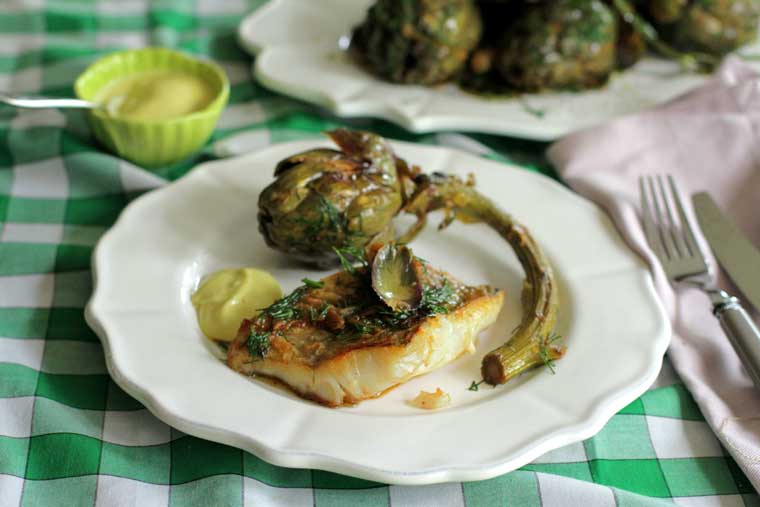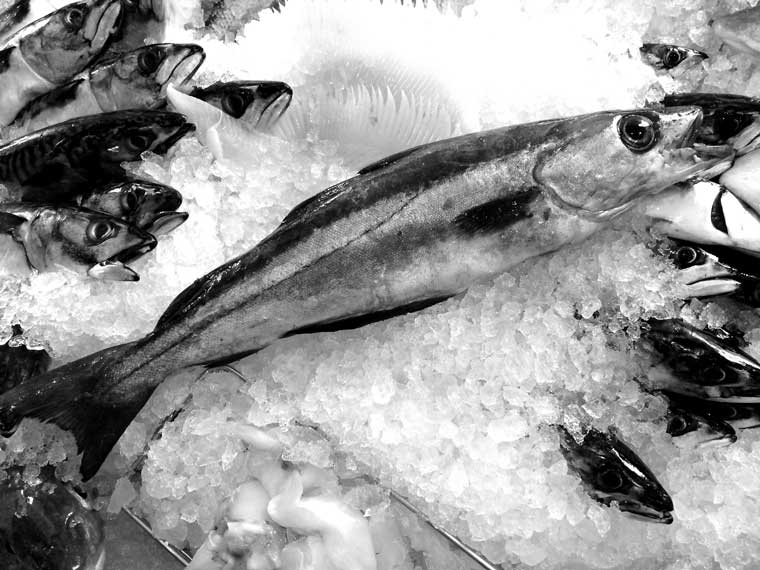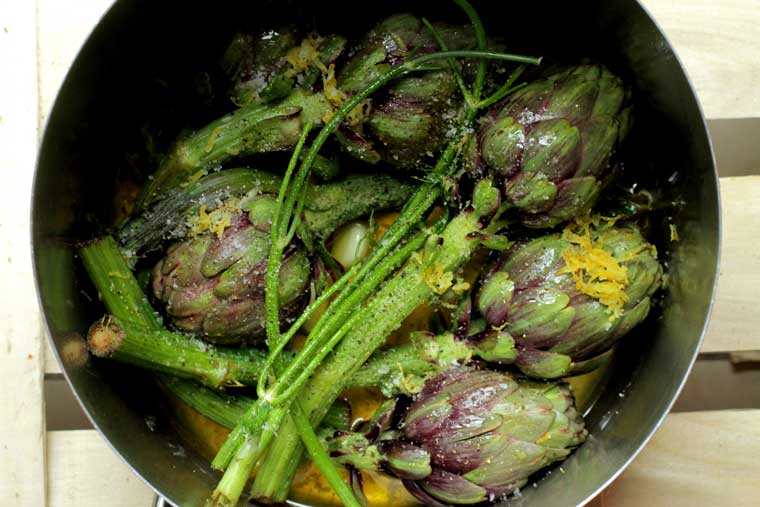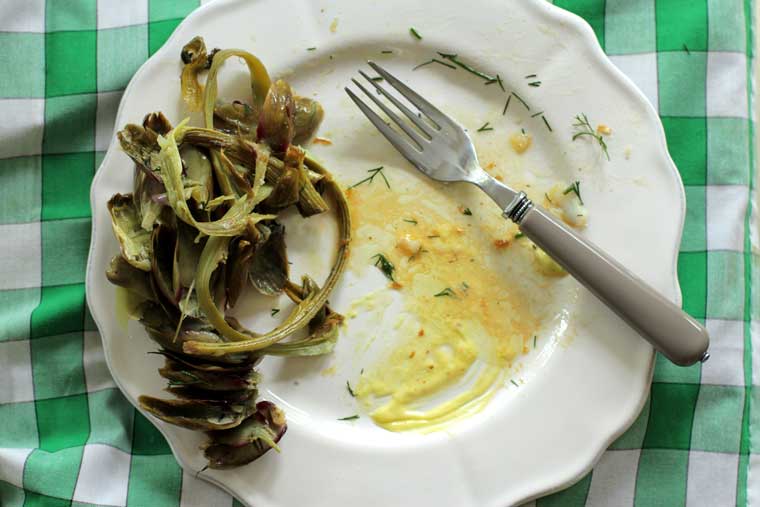June
Barbecues on the beach, jig-caught squid, an abundance of seasonal choice and pan-fried pollack with aioli and baby artichokes. Tom Hunt celebrates what we can enjoy this month.

Summer is officially here. Let’s make the most of it: get down to the beach and enjoy fish at its freshest, straight from the sea! Around this time of year mackerel chase whitebait close into shore, creating a feeding frenzy that makes the sea boil. If you are lucky enough to witness this spectacle with a rod in hand you will be guaranteed easy pickings, flicking flapping fish onto the shore by the dozen.
Back on the land we are having a similar feeding frenzy as we harvest artichokes, asparagus, new season beetroot, broad beans, broccoli, courgettes, the first fennel, French beans and endless other goodies.
The longest day of the year, the summer equinox, is 21 June. The sun rises at 4.43am and sets at 9.21pm, giving us a marvellous sixteen-and-a-half hours of sunlight. I like to celebrate the equinox by watching the sunrise, and where better than the beach to partake in such an enlightening experience? I’d strongly recommend packing up a thick sleeping-bag, a grill and some provisions to spend the night under the stars.
My meal of choice for the occasion, easy to cook and perfect for the barbecue, is jig-caught squid, grilled potatoes and mojo verde, a wonderfully zesty and piquant coriander-based salsa verde from the Canary Islands. Ask your fishmonger to clean the squid and cut each one into 4-6 pieces depending on the size. (And if you’re curious about jigging, it involves dangling a line with one or more bright hooked lures in the water, and jerking, or jigging, it up and down. It’s often done at night under bright lights, which attract the squid.)
Before setting off on your expedition, marinate the squid in a tub or sealable bag with black pepper, crushed garlic, salt and a little olive oil. Boil the potatoes and cut in half lengthways. Make the mojo verde: finely chop 3 cloves of garlic, 1 green chilli, and a small bunch of coriander (including the stalks). Add a dash of wine vinegar and enough extra virgin olive oil to make a thick, sauce-like consistency. Season with salt, pepper and cumin.
When you’re on the beach and your barbecue is white-hot, grill the potatoes until a little charred, lower the grill right down, next to the coals, then flash the marinated squid on the grill for just one minute each side. Serve immediately with a good helping of mojo verde on the side, unconventionally with a glass of red, to warm your cockles.

As the temperature of the North Atlantic rises, many species of fish migrate to our waters. It’s at this time of year that we start to see a really impressive variety of fish landed on the British coast: Atlantic cod, black bream, brown crab, coley/saithe, Dover sole, flounder, haddock, hake, halibut, herring, John Dory, lemon sole, lobster, mackerel, northern or cold water prawns, plaice, pollack, pouting, queen scallops, sardines, sea bass and sea trout.
With all of this choice available, it’s as important as ever to pick wisely. Be flexible about which species you would like to buy, so that you can choose the freshest fish that has been caught using the best methods from fisheries with sustainable stocks: the Marine Conservation Society website is a handy resource for up-to-date information, although not all fish have yet been assessed.
From the huge list of fish available this month, my top recommendations are: the under-valued, marvellous black bream, brown crab (buy hand-picked for the best flavour), coley, farmed halibut, pouting, northern prawns and, my pick of the month, pollack.
Pollack, sometimes spelled pollock and also known as lythe, is a sturdy contender as a cod or haddock alternative. Abundant and usually excellent value, it’s a large fish, so buy by the fillet, allowing 150g per person. Its flesh is similar to coley/saithe, but whiter, and is incredibly versatile. Smoke it, batter it, roast it; what the hell, even eat it raw with wasabi and soya sauce. For this month’s recipe, though, I’m keeping it simple and letting the ingredients speak for themselves: pan-fried pollack, served with aioli and the majestic artichoke.

Pan-fried pollack with aioli and baby artichokes
Artichokes are now in season. They are a seductive vegetable worth a little effort and patience. The poet Pablo Neruda describes this so well in his final paragraph of Ode to the Artichoke: “Leaf after leaf, we undress, its deliciousness, and eat, the peaceful substance, of its green heart”. The uniquely savoury-sweet flavour goes very well with a fresh fillet of white fish and needs little else adding. This meal is inspired by the poem, and is appropriately romantic.
Ingredients
Serves 2
6 baby artichokes, washed
125ml white wine, plus a little extra to deglaze the pan
1 lemon, squeezed and zested
3 cloves garlic, peeled
3 large sprigs of dill, tops roughly chopped, thick stalks kept
50ml extra virgin olive oil, with extra for frying
2 x 150g fillets of pollack, seasoned with salt and pepper
For the aioli
1 organic egg
3 cloves garlic, peeled
150ml extra virgin olive oil

Method
For the artichokes: Place them into a pot, so they all fit snugly on the bottom. Add the lemon juice, zest, garlic, dill stalks, a good slug of olive oil and seasoning of salt and pepper. Add the wine, and top up with water, one third of the way up the artichokes.
Bring to a slow boil, cover with a sheet of greaseproof paper pushed down on top. Place the lid on and simmer for 25 minutes. Keep an eye to make sure the liquid doesn’t all evaporate and add a touch more water if necessary.
Remove the lid and increase the heat to evaporate the rest of the liquid and allow the artichokes to fry in the oil and flavour residues. After 2-3 minutes add a splash of wine and boil vigorously while scraping all the flavoursome bits off the bottom. Remove from the heat and sprinkle the chopped dill on top.
For the aioli: Prepare in advance. Place the egg and garlic in a blender with a pinch of salt and pepper. Turn on and pour in the olive oil in a very slow trickle. If it splits, remove from the blender, add an egg yolk to the blender and then slowly return the mixture to the new egg. Store in a jar in the fridge.
For the pollack: Heat a thick-based frying pan with a glug of olive oil. When hot, add the fillets skin side down. Fry for 5 minutes until the skin is crisp. Turn and fry for 2-3 minutes on the other side until the flesh has just turned opaque.
Serve with the warm artichokes, aioli and some fresh green salad. Dress the fish in the artichoke’s sweet dill liquor.
To eat the artichokes, pull the leaves off one by one scraping the sweet juices and little flesh from the fat end of the leaf. As the leaves get smaller you can bite whole clumps of them devouring most of the flesh. When eating baby artichokes, once you reach the green heart you should be able to eat it in its entirety without worrying about the choke.

Tom Hunt is author of The Natural Cook: Eating the Seasons from Root to Fruit. He founded the Forgotten Feast, a campaign working on projects throughout the UK, to revive our cooking heritage and help reduce food waste and Poco, a festival café and award-winning restaurant in Bristol and (just opened) London’s Broadway Market. Click here to read his blog, Tom’s Feast.





